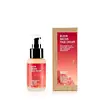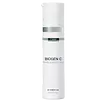What's inside
What's inside
 Key Ingredients
Key Ingredients

 Benefits
Benefits

 Concerns
Concerns

 Ingredients Side-by-side
Ingredients Side-by-side

Aloe Barbadensis Leaf Juice Powder
Skin ConditioningGlycerin
HumectantCoco-Caprylate/Caprate
EmollientPropanediol
SolventPrunus Amygdalus Dulcis Oil
Skin ConditioningWater
Skin ConditioningCetearyl Alcohol
EmollientGlyceryl Stearate
EmollientButyrospermum Parkii Butter
Skin ConditioningPotassium Palmitoyl Hydrolyzed Wheat Protein
CleansingSimmondsia Chinensis Seed Oil
EmollientCaprylic/Capric Triglyceride
MaskingCalanthe Discolor Extract
Skin ConditioningSodium Hyaluronate
HumectantBrassica Oleracea Italica Extract
AstringentHydrolyzed Rhodophyceae Extract
Helianthus Annuus Seed Oil
EmollientVaccinium Vitis-Idaea Fruit Extract
AntioxidantCitrus Grandis Peel Extract
AstringentLavandula Angustifolia Flower/Leaf/Stem Extract
MaskingPrunus Armeniaca Fruit Extract
Skin ConditioningPyrus Malus Fruit Extract
Skin ConditioningCitrus Aurantifolia Peel Extract
CleansingCucumis Melo Fruit Extract
Skin ConditioningMentha Piperita Leaf Extract
Skin ConditioningPrunus Amygdalus Dulcis Bud Extract
Skin ConditioningPrunus Persica Fruit Extract
AbrasiveVanilla Planifolia Fruit Extract
Skin ConditioningAstaxanthin
Skin ConditioningSalvia Sclarea Extract
AntiseborrhoeicSalicornia Herbacea Extract
Skin ConditioningCitrus Aurantium Dulcis Peel Extract
Emulsion StabilisingAgastache Mexicana Flower/Leaf/Stem Extract
Skin ConditioningCarthamus Tinctorius Seed Oil
MaskingGlycine Soja Oil
EmollientGlyceryl Caprylate
EmollientArginine
MaskingLevulinic Acid
PerfumingSclerotium Gum
Emulsion StabilisingLysolecithin
EmulsifyingSilica
AbrasiveSodium Levulinate
Skin ConditioningXanthan Gum
EmulsifyingPullulan
P-Anisic Acid
MaskingSodium Phytate
Beta-Sitosterol
Emulsion StabilisingCalcium Gluconate
HumectantCitric Acid
BufferingPotassium Sorbate
PreservativeGluconolactone
Skin ConditioningSqualene
EmollientTocopherol
AntioxidantSodium Benzoate
MaskingLimonene
PerfumingLinalool
PerfumingAloe Barbadensis Leaf Juice Powder, Glycerin, Coco-Caprylate/Caprate, Propanediol, Prunus Amygdalus Dulcis Oil, Water, Cetearyl Alcohol, Glyceryl Stearate, Butyrospermum Parkii Butter, Potassium Palmitoyl Hydrolyzed Wheat Protein, Simmondsia Chinensis Seed Oil, Caprylic/Capric Triglyceride, Calanthe Discolor Extract, Sodium Hyaluronate, Brassica Oleracea Italica Extract, Hydrolyzed Rhodophyceae Extract, Helianthus Annuus Seed Oil, Vaccinium Vitis-Idaea Fruit Extract, Citrus Grandis Peel Extract, Lavandula Angustifolia Flower/Leaf/Stem Extract, Prunus Armeniaca Fruit Extract, Pyrus Malus Fruit Extract, Citrus Aurantifolia Peel Extract, Cucumis Melo Fruit Extract, Mentha Piperita Leaf Extract, Prunus Amygdalus Dulcis Bud Extract, Prunus Persica Fruit Extract, Vanilla Planifolia Fruit Extract, Astaxanthin, Salvia Sclarea Extract, Salicornia Herbacea Extract, Citrus Aurantium Dulcis Peel Extract, Agastache Mexicana Flower/Leaf/Stem Extract, Carthamus Tinctorius Seed Oil, Glycine Soja Oil, Glyceryl Caprylate, Arginine, Levulinic Acid, Sclerotium Gum, Lysolecithin, Silica, Sodium Levulinate, Xanthan Gum, Pullulan, P-Anisic Acid, Sodium Phytate, Beta-Sitosterol, Calcium Gluconate, Citric Acid, Potassium Sorbate, Gluconolactone, Squalene, Tocopherol, Sodium Benzoate, Limonene, Linalool
Water
Skin ConditioningStearic Acid
CleansingOleic Acid
EmollientGlycerin
HumectantDimethyl Isosorbide
Solvent3-O-Ethyl Ascorbic Acid
Skin ConditioningKrameria Triandra Root Extract
Skin ConditioningGlycine Soja Oil
EmollientCarthamus Tinctorius Seed Oil
MaskingPolyglyceryl-6 Distearate
EmulsifyingTocopheryl Acetate
AntioxidantGlyceryl Stearate Citrate
EmollientPolyglyceryl-3 Stearate
EmulsifyingEucalyptus Globulus Leaf Oil
PerfumingHydrogenated Lecithin
EmulsifyingHexapeptide-11
Skin ConditioningLaminaria Digitata Extract
Skin ProtectingJojoba Esters
EmollientPolyglyceryl-3 Beeswax
EmulsifyingCetyl Alcohol
EmollientChloroxylenol
AntimicrobialCI 42090
Cosmetic ColorantLimonene
PerfumingWater, Stearic Acid, Oleic Acid, Glycerin, Dimethyl Isosorbide, 3-O-Ethyl Ascorbic Acid, Krameria Triandra Root Extract, Glycine Soja Oil, Carthamus Tinctorius Seed Oil, Polyglyceryl-6 Distearate, Tocopheryl Acetate, Glyceryl Stearate Citrate, Polyglyceryl-3 Stearate, Eucalyptus Globulus Leaf Oil, Hydrogenated Lecithin, Hexapeptide-11, Laminaria Digitata Extract, Jojoba Esters, Polyglyceryl-3 Beeswax, Cetyl Alcohol, Chloroxylenol, CI 42090, Limonene
Ingredients Explained
These ingredients are found in both products.
Ingredients higher up in an ingredient list are typically present in a larger amount.
Carthamus tinctorius seed oil comes from safflower, one of humanity's oldest crops.
Safflower seed oil contains a high percentage of linoleic acid and oleic acid. It also contains Vitamin E. These three components are effective moisturizers.
Vitamin E helps nourish your skin's lipid barrier. It is also a potent antioxidant. Antioxidants help fight free-radical molecules, or unstable molecules that may damage your skin cells.
Due to its high fatty acid content, this ingredient may not be malassezia folliculitis safe.
Thoughout history, safflower has been used for dying fabrics and in food as a saffron substitute.
Learn more about Carthamus Tinctorius Seed OilGlycerin is already naturally found in your skin. It helps moisturize and protect your skin.
A study from 2016 found glycerin to be more effective as a humectant than AHAs and hyaluronic acid.
As a humectant, it helps the skin stay hydrated by pulling moisture to your skin. The low molecular weight of glycerin allows it to pull moisture into the deeper layers of your skin.
Hydrated skin improves your skin barrier; Your skin barrier helps protect against irritants and bacteria.
Glycerin has also been found to have antimicrobial and antiviral properties. Due to these properties, glycerin is often used in wound and burn treatments.
In cosmetics, glycerin is usually derived from plants such as soybean or palm. However, it can also be sourced from animals, such as tallow or animal fat.
This ingredient is organic, colorless, odorless, and non-toxic.
Glycerin is the name for this ingredient in American English. British English uses Glycerol/Glycerine.
Learn more about GlycerinGlycine Soja Oil comes from the soybean. Glycine Soja is native to eastern Asia.
Soybean oil is an emollient. It is rich in antioxidants and fatty acids including palmitic, stearic, oleic, and linoleic acids.
As an emollient, the fatty acids in soybean oil helps keep your skin soft and hydrated. It does so by creating a film on top that traps moisture in.
Soybean oil is also rich in vitamin E, a potent antioxidant. Vitamin E is also anti-inflammatory and provides a soothing effect.
Studies show soy may help fade hyperpigmentation from UVB. It does so by disrupting the melanin process from UVB induced skin inflammation.
This ingredient may not be malassezia folliculitis, or fungal-acne, safe.
Soybeans are rich in proteins and are part of the legume family. Foods made with soybeans include tofu, soymilk, edamame, miso, and soy sauce.
Learn more about Glycine Soja OilLimonene is a fragrance that adds scent and taste to a formulation.
It's found in the peel oil of citrus fruits and other plants such as lavender and eucalyptus. The scent of limonene is generally described as "sweet citrus".
Limonene acts as an antioxidant, meaning it helps neutralize free radicals.
When exposed to air, oxidized limonene may sensitize the skin. Because of this, limonene is often avoided by people with sensitive skin.
The term 'fragrance' is not regulated in many countries. In many cases, it is up to the brand to define this term. For instance, many brands choose to label themselves as "fragrance-free" because they are not using synthetic fragrances. However, their products may still contain ingredients such as essential oils that are considered a fragrance.
Learn more about LimoneneWater. It's the most common cosmetic ingredient of all. You'll usually see it at the top of ingredient lists, meaning that it makes up the largest part of the product.
So why is it so popular? Water most often acts as a solvent - this means that it helps dissolve other ingredients into the formulation.
You'll also recognize water as that liquid we all need to stay alive. If you see this, drink a glass of water. Stay hydrated!
Learn more about Water